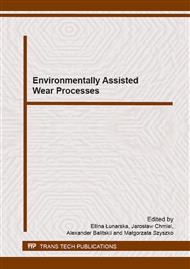p.71
p.77
p.85
p.93
p.101
p.109
p.115
p.123
p.131
Tribological Wear in the Complex Service Conditions
Abstract:
This paper presents an attempt to learn mechanical, corrosive and abrasive wear mechanisms and wear mechanisms in refrigerating compressor systems. The range of author’s examinations includes electrolytic liquids with abrasive material used in the food industry, especially in the sugar industry and lubricating oils polluted with refrigerant occurring in stationary and mobile refrigerating compressor systems. Tests on the wear mechanisms in complex service conditions show that the total wear occurring in tribological pairs due to simultaneous occurrence of destructive processes: frictional, corrosive and abrasive, is not a simple superposition of their individual effects occurring in conditions of their independent interactions. On the basis of carried out experiments with the use of mathematical methods for experimental designs, a statistical model describing the complex process of simultaneous wear was formulated. This model enables forecasting the wear and indicates that the abrasive wear is of dominating character. In the compressor refrigerating systems, the oil–refrigerant system is characterized by complex relations. Refrigerants andcompressor oils create compounds causing the accelerated wear of refrigerating compressors. The complex dependencies in case of the oil–refrigerant compound, cause that the lubricating and anti-wear properties are much worse than in case of pure oil. In case of exceeding their mutual miscibility, part of the agent is absorbed by oil. More stringent regulations concerning the protection of the ozone layer lead to the appearance of new agents creating new compounds with oils. In order to examine the influence of the compounds on the wear processes in the refrigerating compressors, we made a test stand. The stand is built of real elements of the refrigerating system consisting of, among others, a dismountable half-hermetic compressor. The stand, built for testing the model wear processes occurring in the refrigerating compressors, will be used for tribological tests in the atmosphere of refrigerants under regular loads conditions.The purpose of the performed examination is to develop methods of wear phenomena modelling in the complex service conditions in the sectors of food production and refrigerated storage .
Info:
Periodical:
Pages:
101-108
Citation:
Online since:
December 2014
Authors:
Keywords:
Price:
Сopyright:
© 2015 Trans Tech Publications Ltd. All Rights Reserved
Share:
Citation:


